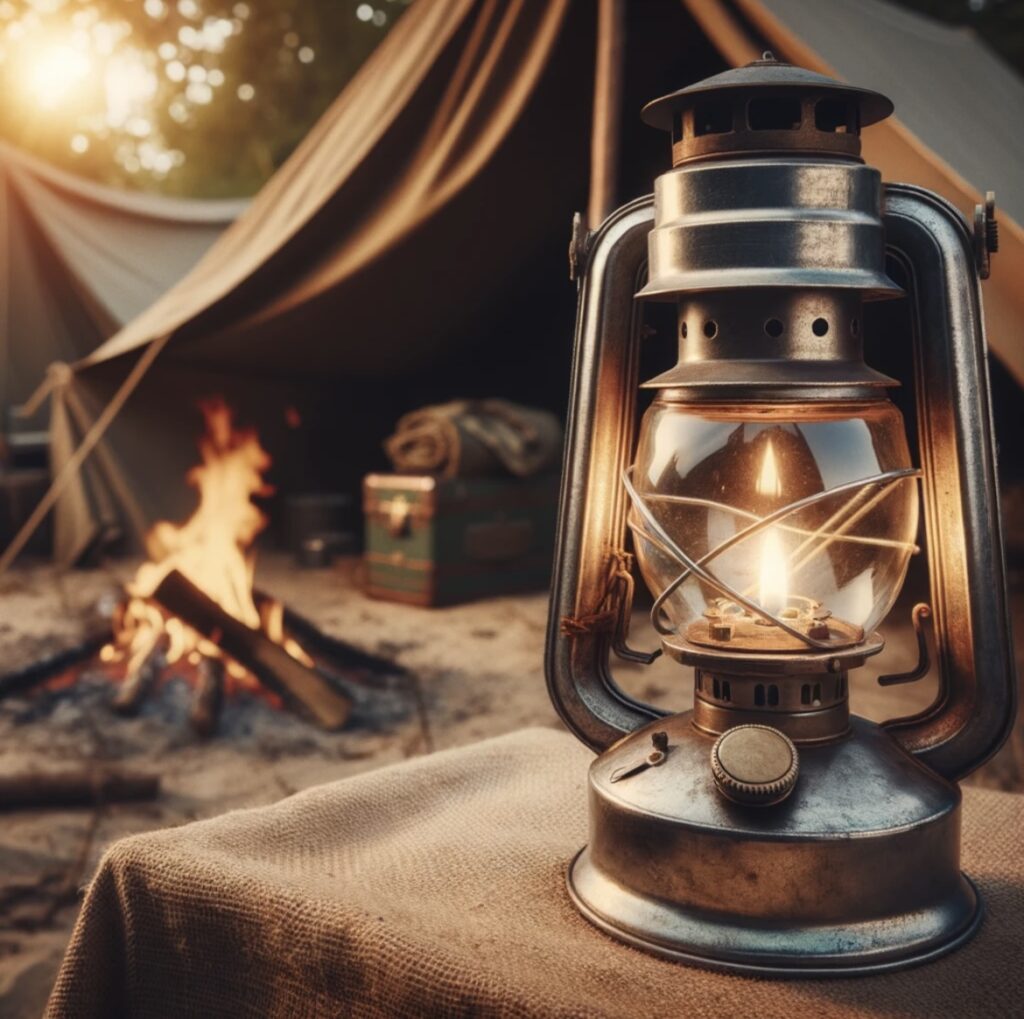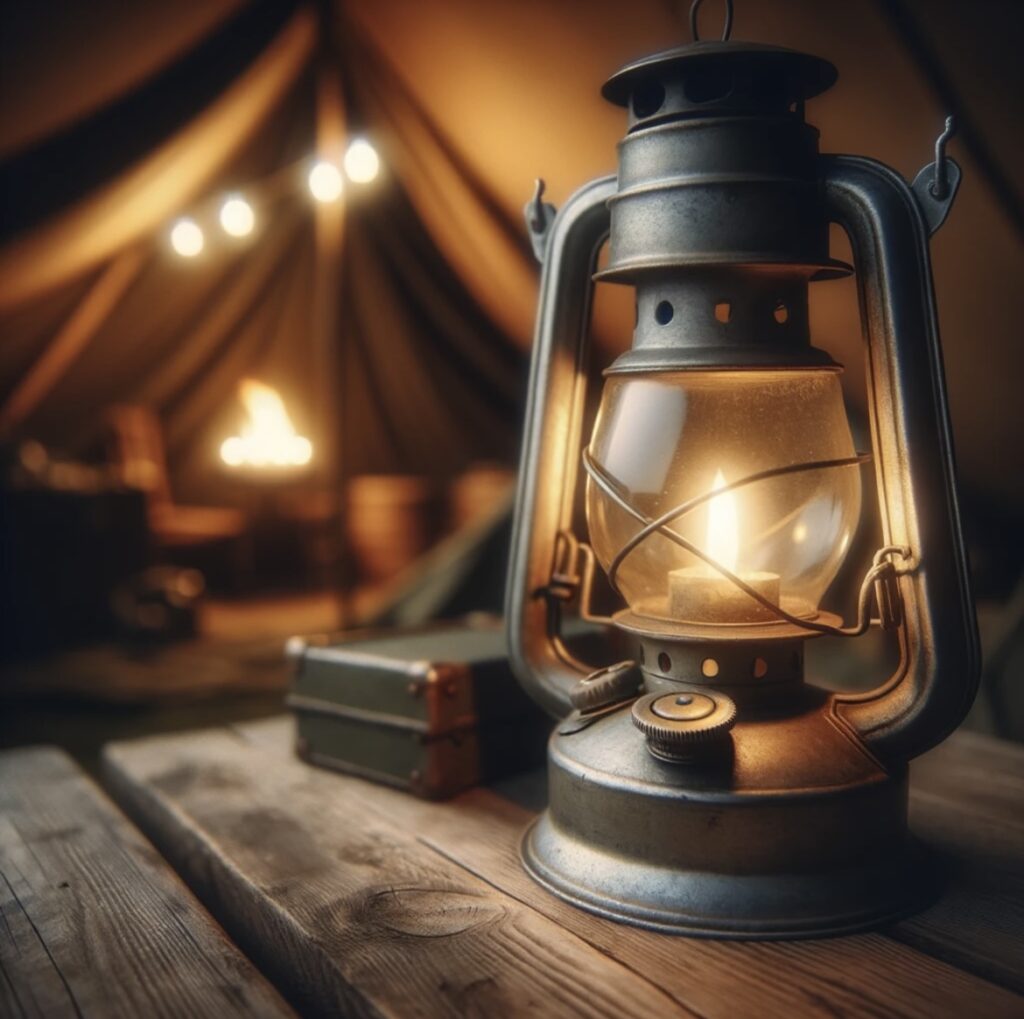Have you ever wondered about the evolution of camping lanterns over time? In this fascinating article, we will take you on a journey through history to explore the remarkable transformation of camping lanterns. From humble beginnings, lanterns have evolved from primitive oil lamps to sleek and efficient LED lights. Join us as we delve into the rich history of camping lanterns and discover the innovations that have shaped the way we illuminate our camping adventures today.

Early Lanterns – Evolution of Camping Lanterns
Primitive Fire-Based Lanterns
In the early days of camping, lanterns relied on primitive fire-based technologies to provide illumination. These lanterns were essentially containers, such as hollowed-out gourds or animal skins, filled with combustible materials like dried moss, straw, or animal fat. A small opening allowed the flame to burn, providing a flickering light source that helped campers navigate the dark. While these lanterns were simple and effective, they posed safety risks due to the open flame and the fragility of the materials used.
Oil Lamps
The development of oil lamps marked a significant advancement in camping lanterns. These lanterns were designed with a reservoir for holding oil and a wick that drew the oil up to be burned. Oil lamps provided a more stable and controlled source of light, reducing the risk of accidents compared to fire-based lanterns. They were often made of metal, such as bronze or tin, which improved durability and heat resistance. Oil lamps became widely popular due to their efficiency, affordability, and ease of use.
Candle Lanterns
Candle lanterns, as the name suggests, utilized candles as their source of light. These lanterns typically consisted of a sheltered chamber with transparent sides to protect the flame from the wind and elements. Candle lanterns provided a soft and cozy glow, creating a warm atmosphere for camping. They were relatively lightweight and portable, making them a popular choice for campers seeking simplicity and convenience. However, the limited burn time of candles meant that campers needed to carry additional candles or replace them frequently during extended camping trips.
Gas-Powered Lanterns
Introduction of Gas Lanterns
The introduction of gas lanterns revolutionized camping illumination. Gas lanterns utilized pressurized fuel, such as propane or butane, to produce a bright and steady flame. These lanterns featured a control valve that allowed users to adjust the intensity of the light. Gas lanterns quickly gained popularity among campers due to their powerful illumination, long burn time, and ease of operation. They were particularly favored for their ability to withstand wind and harsh weather conditions, making them a reliable choice for outdoor adventures.
Development of Gas Lanterns
Over time, gas lanterns underwent further developments to enhance their performance and efficiency. Manufacturers introduced features like built-in igniters, improved fuel efficiency, and adjustable mantles. These advancements made gas lanterns even more user-friendly and reliable. The mantles, which were made of heat-resistant fabric soaked in a solution of rare earth metals, significantly increased the brightness of the flame. The introduction of mantles marked a significant milestone in gas lantern technology, providing campers with a brighter and more efficient light source.
Mantle Lanterns
Mantle lanterns became a popular choice for campers seeking powerful and bright illumination. These lanterns incorporated a fabric mantle that glowed with intense light when heated by the gas flame. Mantle lanterns offered superior brightness and extended burn times compared to their predecessors. The mantle technology also allowed for a more focused and directional light output, making them ideal for tasks that required precise illumination, such as cooking or reading. However, campers needed to handle mantle lanterns with care, as the mantles were delicate and prone to damage.
Electric Lanterns
Introduction of Electric Lanterns
The advent of electric lanterns revolutionized camping lighting once again. Electric lanterns utilized electricity to power their light source, eliminating the need for open flames or combustible fuels. Early electric lanterns were bulky and required external power sources, such as generators or batteries connected via cords. Despite their limitations, electric lanterns provided a safer and more convenient option for campers, especially in settings where open flames were prohibited or impractical.
Battery-Powered Lanterns
Battery-powered lanterns emerged as a game-changer for camping illumination. These lanterns were equipped with built-in rechargeable batteries or replaceable batteries, providing a portable and self-contained power source. Battery-powered lanterns offered long-lasting illumination, often incorporating energy-efficient LED bulbs to maximize battery life. This made them ideal for extended camping trips or situations where access to electricity was limited. With advancements in battery technology, modern battery-powered lanterns have become even more compact, lightweight, and energy-efficient.
Solar-Powered Lanterns
Solar-powered lanterns tapped into the renewable energy of the sun to provide illumination. These lanterns featured built-in solar panels that absorbed sunlight during the day to charge internal batteries. As evening fell, the stored energy powered the lantern, offering a sustainable and eco-friendly lighting solution. Solar-powered lanterns proved particularly useful in remote camping locations with ample sunlight, as they eliminated the need for external power sources or batteries. They also reduced the impact on the environment by minimizing the use of disposable batteries or fuels.

Compact and Portable Lanterns
Advancements in Compact Lanterns
Advancements in technology led to the development of compact and portable lanterns, catering to the needs of modern campers who prioritize convenience and ease of transportation. These lanterns were designed to be lightweight, compact, and collapsible, making them highly portable and space-efficient. Compact lanterns often incorporated folding handles or hooks, allowing campers to hang them from tents or branches for hands-free illumination. These lanterns were typically battery-powered, utilizing energy-efficient LED bulbs to provide ample brightness while maximizing battery life.
LED Lanterns
LED lanterns emerged as a popular choice for campers seeking efficient and long-lasting lighting options. LED (Light Emitting Diode) technology offered significant advantages over traditional incandescent bulbs, including lower energy consumption, extended lifespan, and improved durability. LED lanterns provided bright and even illumination, with some models offering adjustable light intensity or color temperature settings. The low power requirements of LED bulbs made them ideal for battery-powered lanterns, ensuring extended burn times and reduced energy consumption.
Collapsible Lanterns
Collapsible lanterns gained popularity among campers due to their space-saving design and versatility. These lanterns featured a collapsible body or accordion-style construction that allowed them to be easily folded or flattened for compact storage. The collapsible design made these lanterns highly portable, occupying minimal space in backpacks or camping gear. When expanded, collapsible lanterns provided a 360-degree illumination, ensuring even distribution of light in all directions. Some models even incorporated additional functionalities, such as built-in power banks or USB charging ports, making them multi-purpose camping companions.
Specialized Lanterns
Rechargeable Lanterns
As environmental consciousness grew, manufacturers introduced rechargeable lanterns as a sustainable alternative to disposable battery-powered options. Rechargeable lanterns featured built-in rechargeable batteries that could be easily replenished using various power sources, such as USB ports, solar panels, or hand-crank generators. These lanterns emphasized reduced waste and long-term cost savings, as campers could recharge and reuse them multiple times without the need for disposable batteries. Rechargeable lanterns also often incorporated energy-efficient LED bulbs for extended burn times.
Waterproof Lanterns
Waterproof lanterns emerged to meet the needs of campers venturing into wet or rainy environments. These lanterns were designed with robust and durable materials, such as rubberized casings or IPX-rated waterproofing, to withstand water exposure. Waterproof lanterns offered protection against rain, splashes, or accidental immersion, ensuring reliable illumination even in challenging conditions. These lanterns often featured sealed compartments or secure closures, preventing water from infiltrating and damaging internal components. Waterproof lanterns became an essential gear for water-related activities, such as boating, fishing, or camping near bodies of water.
Backpacking Lanterns
Backpacking lanterns catered specifically to the needs of hikers and backpackers who prioritize lightweight and compact gear. These lanterns were designed to be ultra-portable, often weighing only a few ounces and occupying minimal space in backpacks. Backpacking lanterns offered sufficient illumination for nighttime campsites while minimizing the added weight and bulk. They typically featured efficient LED bulbs, low power consumption, and some models even had versatile attachment options like removable clips or straps. Backpacking lanterns enabled campers to enjoy the benefits of reliable illumination without compromising on the weight or size of their backpacks.
Technological Innovations
Bluetooth-Enabled Lanterns
Technological advancements brought about the integration of Bluetooth connectivity into camping lanterns, adding new dimensions to the camping experience. Bluetooth-enabled lanterns allowed campers to control the illumination and settings of their lanterns remotely through smartphone applications. Users could adjust light intensity, change colors, set timers, or even sync the lanterns with music or ambient sounds for a customizable camping ambiance. Bluetooth connectivity also facilitated connectivity with other camping gadgets or smart devices, further enhancing the convenience and versatility of modern camping lanterns.
Smart Lanterns
Building on the foundation of Bluetooth-enabled lanterns, smart lanterns represented the pinnacle of technological innovation in camping illumination. These lanterns incorporated advanced features like motion sensors, built-in cameras, GPS tracking, and voice command capabilities. Smart lanterns offered not only powerful illumination but also multifunctionality and added safety features. Users could set motion-activated lighting, capture photos or videos of their camping experiences, track their lantern’s location, or even interact with the lantern using voice commands. Smart lanterns transformed camping illumination into a truly futuristic and connected experience.

Sustainable Lanterns
Introduction of Eco-Friendly Features
With a growing emphasis on environmental sustainability, lantern manufacturers introduced eco-friendly features to reduce their carbon footprint. This included the implementation of energy-efficient LED bulbs, which consumed significantly less power compared to traditional bulbs. Manufacturers also adopted recyclable materials and minimized the use of hazardous substances in lantern construction. Packaging and production processes were optimized to minimize waste and promote eco-friendly practices. Campers seeking greener alternatives embraced these sustainable lanterns, contributing to a more sustainable camping industry overall.
Bio-Lanterns
Bio-lanterns represented an innovative approach to sustainable camping lighting. These lanterns utilized organic or biodegradable materials, such as bamboo, paper, or bioplastics, in their construction. Bio-lanterns often incorporated natural fuel sources, like beeswax or vegetable oils, to eliminate the dependence on fossil fuels or disposable batteries. These lanterns were designed to leave a minimal ecological footprint, decomposing naturally or being easily recycled. Bio-lanterns catered to environmentally conscious campers who wanted to enjoy the great outdoors while minimizing their impact on the environment.
Modern Camping Lantern Designs
Minimalist Lanterns
Minimalist lanterns embraced a simplistic and functional design philosophy, focusing on compactness, sleek aesthetics, and streamlined functionality. These lanterns featured clean lines, lightweight materials like aluminum or titanium, and minimalist controls. Minimalist lanterns offered essential features like adjustable brightness, battery indicators, and durability, while eliminating unnecessary complexities. Their compact form factor made them ideal for minimalist campers or those seeking to travel light. Minimalist lanterns were a reflection of the modern camping ethos, prioritizing simplicity and efficiency without compromising on illumination quality.
Multifunctional Lanterns
Multifunctional lanterns aimed to maximize utility and versatility, offering a range of features beyond illumination. These lanterns incorporated additional functionalities like built-in power banks for charging mobile devices, emergency signaling modes, or even integrated speakers for playing music. Some multifunctional lanterns doubled as flashlights or mounted lights, catering to various lighting needs in different scenarios. These lanterns alleviated the need for carrying multiple devices, providing an all-in-one solution for camping convenience. Multifunctional lanterns were favored by campers seeking practical and multi-purpose gear to optimize their camping experience.
Designer Lanterns
Designer lanterns merged functionality with artistic aesthetics, elevating camping illumination to a new level of visual appeal. These lanterns combined stylish and innovative designs with high-quality materials and craftsmanship. Designer lanterns featured unique shapes, patterns, colors, and finishes that added a touch of elegance and sophistication to camping gear. They were often made with premium materials like hand-blown glass, fine ceramics, or sustainable wood, giving them a distinctive and luxurious appearance. Designer lanterns showcased the fusion of functionality and aesthetics, allowing campers to illuminate their camping space with both style and substance.
Integration with Outdoor Gear
Lantern Accessories
Lantern accessories expanded the capabilities and usability of camping lanterns, offering additional convenience and functionality. These accessories included various mounting options, such as magnetic bases, carabiner clips, or adjustable stands, allowing campers to secure or hang their lanterns in different locations. Lantern hangers or hooks provided a practical solution for suspending lanterns from tents, branches, or other elevated surfaces. Diffuser attachments and color filters allowed for customized lighting effects. Reflective shields or reflectors directed the light beam in specific directions, optimizing illumination for specific tasks. Lantern accessories enabled campers to tailor their lighting setups to suit their individual needs, enhancing the flexibility and versatility of camping lanterns.
Lantern-Incorporated Gear
Innovations in camping gear led to the integration of lanterns into various equipment, serving dual purposes while minimizing bulk and weight. Tents and shelters started incorporating built-in lantern attachments or pockets, providing convenient and secure placement for lanterns. Sleeping bags and camping pillows were designed with built-in light panels, allowing campers to have a soft and ambient glow within their sleeping space. Backpacks incorporated compartments or hooks to store and carry lanterns seamlessly. Lantern-incorporated gear streamlined the camping experience, eliminating the need for separate accessories while enhancing overall functionality.
The Future of Camping Lanterns
Advancement in Battery Technology
The future of camping lanterns lies in continuous advancements in battery technology. Manufacturers are working on developing high-capacity and long-lasting batteries that are lightweight and efficient. These advancements will result in lanterns that offer extended burn times, reduced recharge intervals, and improved overall performance. Lithium-ion batteries, for example, are being further optimized for camping lanterns, offering exceptional power density and longevity. As battery technology evolves, campers can expect lighter, longer-lasting, and more reliable lighting solutions for their outdoor adventures.
Incorporation of AI
The integration of artificial intelligence (AI) into camping lanterns holds great potential for enhanced functionality and user experience. AI-enabled lanterns can analyze environmental conditions, such as ambient light levels, weather patterns, or individual preferences, to automatically adjust lighting output and optimize energy consumption. These lanterns can learn and adapt to user behavior, providing personalized illumination solutions. AI algorithms can also incorporate safety features like motion detection, emergency response systems, or intelligent power management. The incorporation of AI will transform camping lanterns into intelligent companions that anticipate and cater to campers’ needs in an intuitive and efficient manner.
Wireless Charging
Wireless charging technology is poised to revolutionize the way we power camping lanterns. Future lanterns may feature built-in wireless charging capabilities, eliminating the need for cumbersome cords or plugs. Campers will be able to simply place their lanterns on designated charging pads or stands to replenish the batteries effortlessly. Wireless charging will not only provide convenience but also eliminate potential damage or wear on charging ports. This technology will enable campers to easily recharge their lanterns wherever wireless charging stations are available or even through portable power banks, ensuring uninterrupted illumination during their outdoor adventures.
In conclusion, the evolution of camping lanterns has come a long way from humble fire-based lanterns to advanced, sustainable, and technologically enhanced illumination solutions. From primitive gourd lanterns to modern wireless charging capabilities, each iteration of camping lanterns has aimed to provide campers with reliable and versatile sources of light. Looking ahead, technological advancements, sustainable practices, and user-centric design will continue to shape the future of camping lanterns, providing campers with ever more efficient, convenient, and immersive lighting experiences in the great outdoors.



Leave a Reply